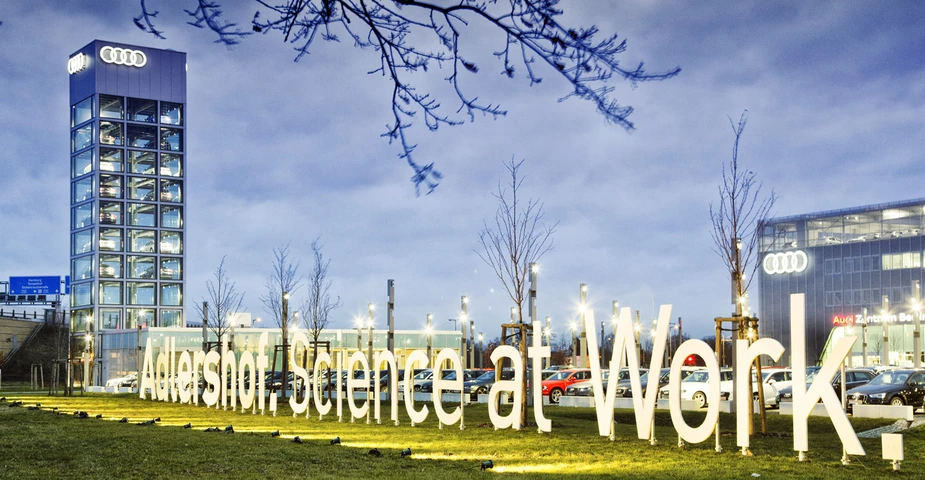Tenacity required
Technology parks need more than one election period for success
Technology park developers must be far-sighted planners as well as smart and eager networkers. Apart from the courage to go down new paths, they have to be but one thing: tenacious. The iniators of such high-tech parks, usually policy makers, are impatient. Why the success story of the Technology Park Adlershof would have been impossible without the perseverance of its developers and sponsors.
According to an old proverb, “Rome wasn’t built in a day.” The same applies to the Science City Adlershof and the Technology Park at its core, despite short-term political decisions and even though some of the seemingly neverending construction sites of the German capital are seriously testing the patience of its citizens. Nevertheless it has become a scientific and economic heavyweight and Berlin today is unimaginable without it. The Technology Park Adlershof, which turned 25 in 2015, is the largest location for science and business in Germany and ranks among the most important in Europe. It is a place where 16,000 people work, research and learn in more than 1,000 companies and 16 research institutions as well as a place with over 6,000 students in physics, mathematics, computer science, chemistry, geography and psychology. People are also starting to want to live here.
What seems like a seamless success story today started out as a project with very little support. Until Germany’s reunification, Adlershof was one of the GDR’s most important sites for natural scientific research and home to 5,500 employees. Those institutes were liquidated. The area wasn’t a pretty sight in those days. A number of important regional players including representatives of Berlin’s government, the Chamber of Industry and Commerce, Berlin’s Economic Development Association and the KAI-ADW, the agency responsible for the coordination of the liquidation of the GDR’s Academy of the Sciences, developed a ten-point programme for the future of Berlin-Adlershof. On the basis of this programme, Berlin’s Senate decided to develop the location into an “integrated landscape for business and science” in 1991. About 300 million DM and a time frame of three years were calculated. This target turned out to be unrealistic. In the end, it took several election periods and required investments – public as well as private – of about two billion euro to turn a question mark into the powerful engine for economic growth Adlershof is today.
Its economic development was a laborious process. Great amounts of money flowed into the project from the European Regional Fund and the GRW Joint Task for Improving Regional Economic Structures. Young technology companies received funding for development from business boost programmes such as the FIT-Anschubprogramm. The site received a significant boost from the decision to build the synchrotron facility Bessy II and to relocate the Humboldt-Universität’s natural science institutes to Adlershof – against considerable resistance.
Important factors included not only the time that Adlershof had for development, but also the trust that policy makers had in the managers of the Technology Park as well as the expertise of the board of directors, which gave policy and business a strong voice. Industry grandees such as Lothar Späth, Hans Peter Stihl and Manfred Genz were on the supervisory committee of WISTA-MANAGEMENT GMBH (Wista), the company that pulled the strings in Adlershof. Moreover, in the case of Adlershof, all of the Berlin’s Senate departments were working towards a common goal. Policy makers watched out that the technology park project was kept out of the ups and downs of election periods and enabled continuous development.
So how about today? Do we still need to be patient with the Technology Park Adlershof, or is it a sure-fire success? According to Roland Sillmann, who became the top manager of the operating company Wista a year ago, the site has now entered a new phase. Infrastructure development has almost been completed. Adlershof has become an attractive location for investment and the balance sheet is outstanding with regard to the increase in companies and employment. “We are now focusing on strengthening service, bringing together founders with large and medium-sized companies and shortening innovation cycles.”
At the same time, much time and effort is going into developing more of Berlin’s places of future innovation. This includes the technology and start- up centre FUBIC („Business and Innovation Center next to Freie Universität Berlin Campus“) in Dahlem, several areas around the University of Applied Sciences in Schöneweide and “Berlin TXL. The Urban Tech Republic”. The latter will be developed on the area of Tegel Airport following its closure. “We are hoping that policy-makers will give us the same level of trust and support as they did in Adlershof,” says Sillmann.
By Sylvia Nitschke for Adlershof Journal
